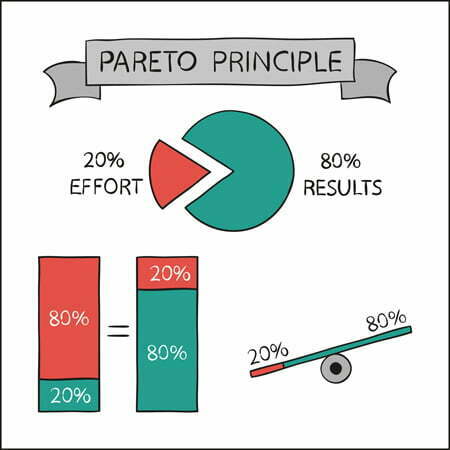
You may have heard of the 80/20 principle and how to apply it in your life. But in corporate governance, what benefits does the 80/20 rule bring?
Let’s explore with Malu how to optimize corporate governance through the 80/20 rule.
>> Other interesting articles from Malu:
- 7 Principles of Building a Modern Business Strategy
- Core Values: What Are Your Core Values?
- Customer Experience: Enhancing Customer Experience
- Market Research – 6 Steps of Effective Market Research
- Product Life Cycle – Product Life Cycle Concepts In Marketing
- The 3C Principles For Better Creativity
Mục lục bài viết
Toggle1. What is the 80/20 Rule? The importance of the 80/20 rule
The 80/20 principle (also known as the Pareto rule) is a very famous economic principle. It is named after the Italian economist: VF Damaso Pareto, for his work from the late nineteenth century.
His research shows an “imbalance” between the efforts we put in, and the results we get. That asymmetry can be visualized through the following talking numbers:
- 20% of salespeople make up to 80% of the company’s revenue.
- 20% of customers bring up to 80% of business revenue.

A study from Kevin Kruse , a veteran Forbes writer, author of the popular book ” Great Leaders Have No Rules” , interviewed hundreds of self-made billionaires , Distinguished students from major American universities, and Olympic medalists have shown that:
“It is impossible for successful people in their fields to devote 100% of their time to the work they take in during the day . The way for them to continue to be successful in the path they have chosen is to apply the 80/20 rule at work.”
Interviewees emphasized the importance of the 80/20 rule: They choose the most important tasks every day, and focus their time and energy on solving it. The rest of the work, they delegate to others to do, or simply “ignore it”.
2. Applying the 80/20 principle to corporate governance
We’ve seen how the 80/20 rule can be of great benefit to businesses. But how can we master that principle? Let’s go with Thi Cao to find out:
In labor productivity management
You understand that:
- 20% of the company’s core product comes from 80% of the employees’ efforts.
Even:
- 80% of the value of a product or service comes from 20% of its most important features.

Obviously, your efforts don’t always pay off. There will be jobs that will prove to be more important than others.
Example:
In the phone product you launch, there is a facial recognition feature. This is a feature that none of your competitors have the potential and technology to integrate into their products. This is clearly your unique competitive advantage . It can be the main feature that attracts customers’ attention, and generates huge revenue for the business.
Your business knows that you must focus most of your resources on this feature, if you want the product to launch successfully and become a new “power” in the mobile phone market in the future.
Another example:
The chain of coffee shops of your business has establishments that generate more revenue than the rest. You estimate: 80% of a business’s revenue comes from the top 20% of businesses.
From the example above, you already know which business you need to focus your resources on.
In time management
When you go to raise capital from investors interested in your business, you realize a fact that:
- 80% of the capital of the business comes from 20% of investors
You don’t have enough time to constantly meet and communicate with 100% institutional investors. So, you decide you’re going to invest the time building and maintaining strong partnerships with the 20% of investors who can bring the greatest benefit to your business.
Under another aspect of corporate governance:
The business car you supply to the market is going through the biggest recall in the past 5 years. You are having a hard time determining the cause of this recall.
Tracking customer feedback, you notice: 80% of customer complaints come from 20% of certain failures . The failures mostly stem from the reason that the shock absorber of this shipment does not work as well as expected.
To verify, your company decided to let the company’s R&D department find out more about the problem. In the report sent to the superior, the shock absorber was also the first reported cause.

In many cases, it’s not possible to give up all of your work time to handle 100% of the day’s workload. When applying the 80/20 rule, you realize that: I need to classify the importance of the work, and determine that I will spend 80% of my work time dealing with the most important 20% .
The remaining volume, it is best to handle it later, or simply delegate to junior staff.
In warehouse management
In the course of your business, you discover: 80% of inventory costs come from 20% of customers . If the cause of the problem can be found, it is likely that the company’s inventory costs will be significantly reduced, and the revenue will also be optimized.

That’s why in the management of transportation and distribution of goods, you need to set up a separate group of goods. For each group of goods, we have a different management approach to minimize costs and improve storage efficiency.
In addition, in this case, you need to communicate directly with the customer, find out the cause of the cost, and come up with the optimal solution to the problem.
In customer management
In business, 80% of a business’s revenue comes from 20% of its customers . We often mistakenly believe that all customers are equal and should be treated equally. In fact, things are not so simple. There will be a group of customers that bring more benefits to the business than the rest.

The cost to maintain and develop the old customer file is not cheap. You also don’t want your investment dollars to go to waste and in vain.
Determining a customer management strategy from the beginning is necessary for every business, if you don’t want to lose your core customer file.
3. 7 Golden Rules of Business Administration
Besides the 80/20 rule, you also need to master the following 7 useful principles to optimize the management of your business.
Respect the law
In order for enterprises to compete in an equal business market, the state and regulatory organizations often issue different legal frameworks.

If you don’t want to be subject to penalties, or tarnish your business’s image in the public eye, your business needs to understand and strictly follow the laws and relevant business practices. mandarin.
Balancing planning and reality
Setting yourself a development plan is a necessity. But how to balance the elements of planning and results in reality is not a simple thing.

A good manager must be the one who sets the number of feasible plans, as close to reality as possible. That helps you steer the business boat effectively and prevent unpredictable uncertainties that may occur.
Specialization
A good business administrator must be the one who knows how to coordinate and arrange talented people to do the work with the highest efficiency.
We humans are not all “well-versed in many professions”. There will be areas where we are extremely good, or extremely bad. The manager’s job is to recognize what employees are best at, and take that skill to the next level.
Focus on the customer
In today’s developing technology era, it is the customer that we need to focus on, instead of the product as in the traditional view. Because customers now have too many choices. Any strategy that is not “customer” can make them easily leave you, in just a few “notes”.

The customer must be the one to decide the shape and nature of the products the company launches into the market. All distribution, marketing, and pricing activities of an enterprise must go through the process of first consulting the needs, wants and tastes of customers.
>> Difference Between Customer Satisfaction and Customer Loyalty
Harmonious combination of interest groups
In enterprises, there are five different groups of interests, including the interests of employees, the interests of customers, the interests of business partners, the interests of investors and the interests of society.
There will be common interests within the groups, but there may also be mutual interests. The task of managers and businesses is to recognize and balance the benefits between different groups of objects.
Know how to take advantage of the unique strengths of the business
When developing, each business has its own strategy and unique business advantages. This is the key factor for them to be able to compete with a forest of competitors with similar characteristics and styles.

Observing and promoting strengths is the way for businesses to stand out, attract customers and thrive.
>> Discover the Brand’s Differential Competitive Advantage
Seize market opportunities
Developing your own strengths is not the only factor that helps businesses succeed. More importantly, they also have to seize opportunities from the external environment to reach out.
Take for example the giant Google:

Strength in algorithms and code is not the only factor that makes Google one of the most valuable businesses in the world. More importantly, they took advantage of the rise of mobile devices (by acquiring and developing Android), monitoring users’ Internet usage trends (acquiring YouTube, developing search algorithms, etc.) ,…).
Hopefully, you have gained more understanding of the 80/20 principle, as well as being able to apply them to the management of your business.
Read more Malu brand articles .




